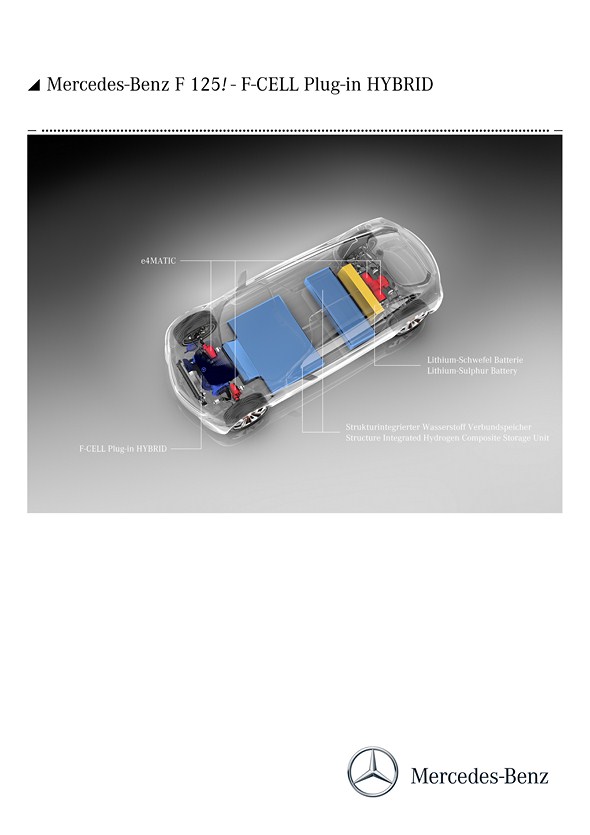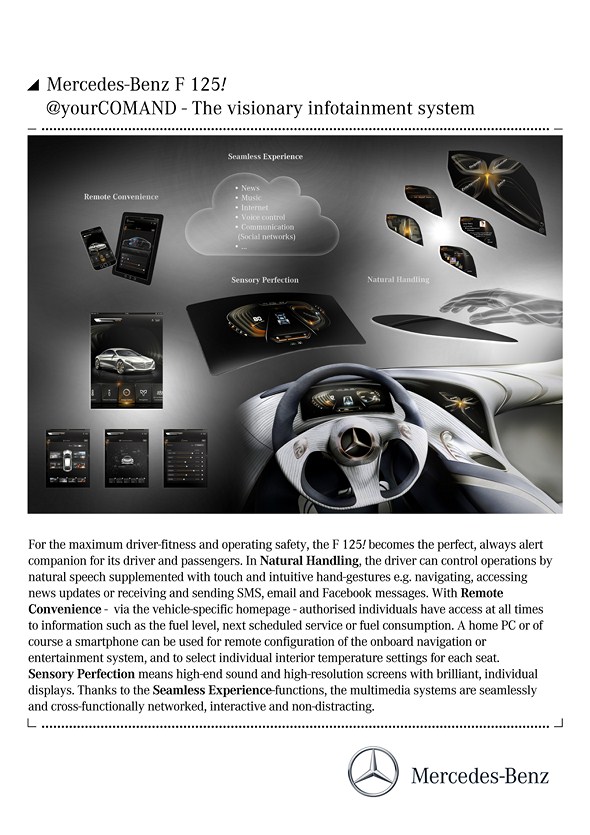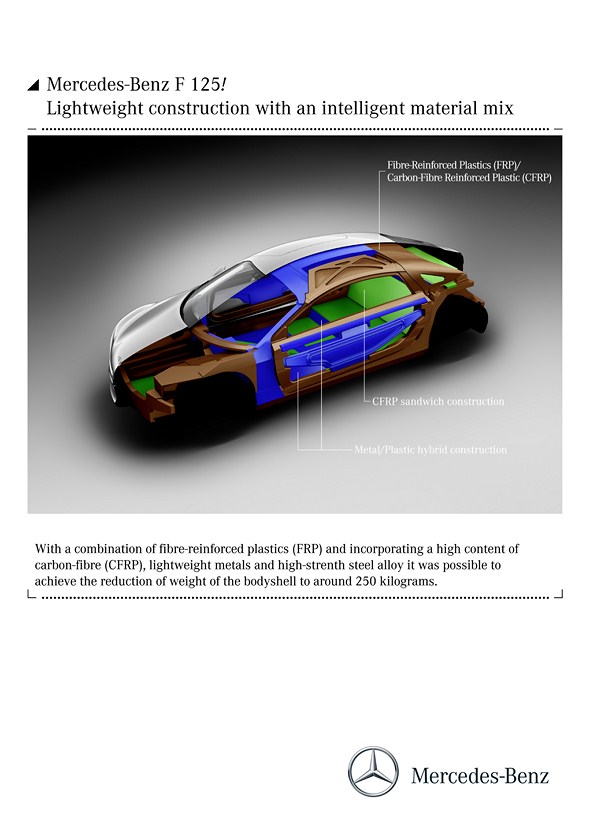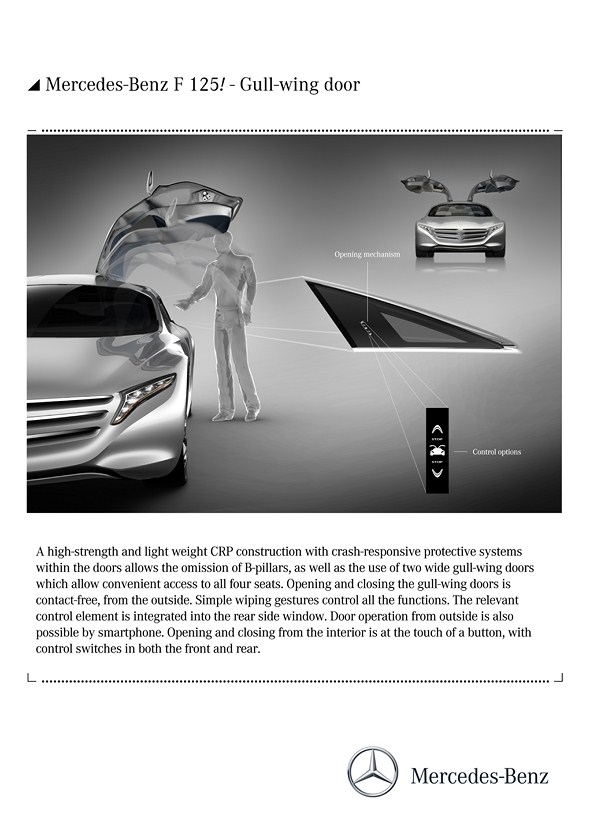The new Mercedes-Benz F 125! research vehicle


Redefinition of automotive luxury: emission-free driving in First Class
- Trailblazing concept for large, luxurious automobiles
- F-CELL Plug-in HYBRID with a range of 1000 km
- Revolutionary hydrogen storage technology
- Lithium-sulphur high-voltage battery with high energy density
- Pioneering battery charging by induction
- e4MATIC–all-wheel drive with four wheel electric motors and individual torque control at each wheel
- Bodyshell of lightweight hybrid construction with gull-wing doors for optimal access, more safety and reduced weight
- Innovative saloon car architecture of avantgarde design
- Driver-fitness safety and ease of operation at the highest level, thanks to natural touch, gesture and voice control
- Always online, always connected with “@yourCOMAND” Cloud-based infotainment
As a highlight marking 125 years of the automobile, Mercedes-Benz is presenting a visionary outlook on future technical developments in the luxury segment. The F 125! research vehicle anticipates future trends and prepares the way for implementation of an innovative premium concept for large, luxurious automobiles.
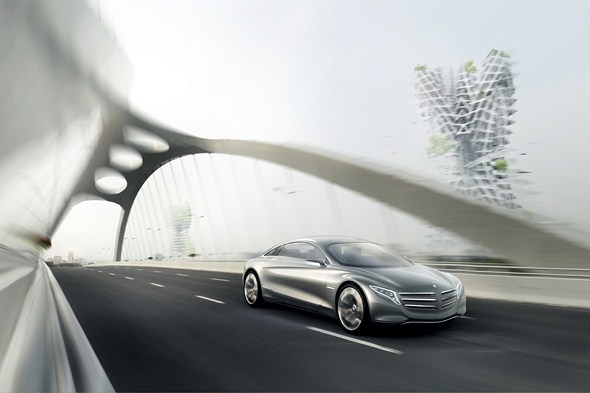
In the F 125! Mercedes-Benz rigorously follows its vision of emission-free driving with hydrogen power, underlining the potential of H2 as an energy source for the future.
While previous Mercedes-Benz research vehicles have “looked ahead” by roughly one vehicle generation – seven to eight years – the F 125! as the latest technological visionary goes a whole step further, by more than two generations to the year 2025 and beyond.
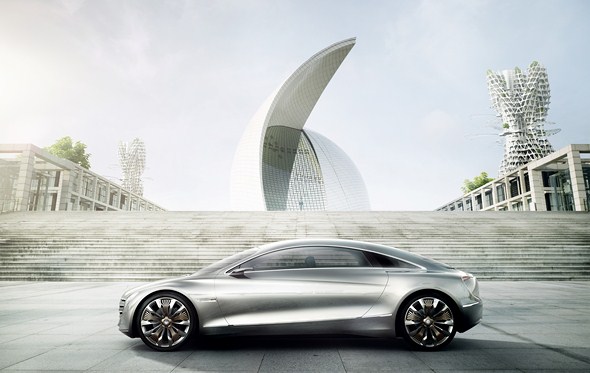
“With the F 125! we want to show that large, comfortable and safe saloon cars have an excellent future, partly because they are able to operate with no emissions.
The legend that is the S-Class will continue into the future thanks to intelligent solutions that always have the customer’s needs in mind,” says Prof. Dr. Thomas Weber, member of the Board of Management of Daimler AG, responsible for Group Research and Mercedes-Benz Cars Development.
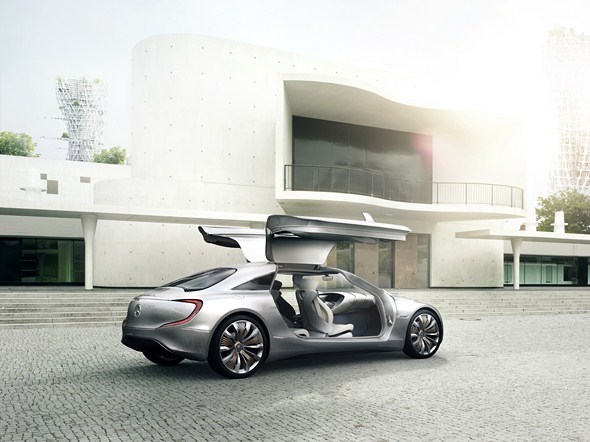
“The new research vehicle illustrates and underlines this claim to leadership with innovative ideas and traditional Mercedes strengths in the areas of design, safety, comfort and performance.”
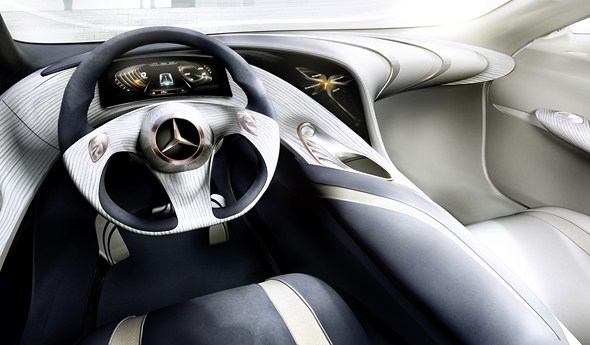
Innovative ideas reaffirm the claim to leadership in the luxury segment
The F 125! demonstrates how completely emission-free, individual mobility might be realised in the luxury segment in the future.
The researchers and developers at Mercedes-Benz have incorporated already well-proven concepts and technologies which are not yet available today, but for which basic research has shown great future promise, and therefore a realistic chance of implementation in future series-production cars.
The decisive innovations are:
- A logical further development of the fuel cell drive system in combination with plug-in technology
- Revolutionary tank technology: the structure integrated hydrogen composite storage unit.
- Lighter and more powerful batteries, in this case based on lithium-sulphur technology, which Mercedes-Benz is examining in parallel with further development of the current lithium-ion battery and research into lithium-air technology.
On this basis the F 125! was created as an innovative four-seater luxury saloon with a powerful, emission-free electric drive system based on the fuel cell technology developed to series production maturity by Mercedes-Benz.
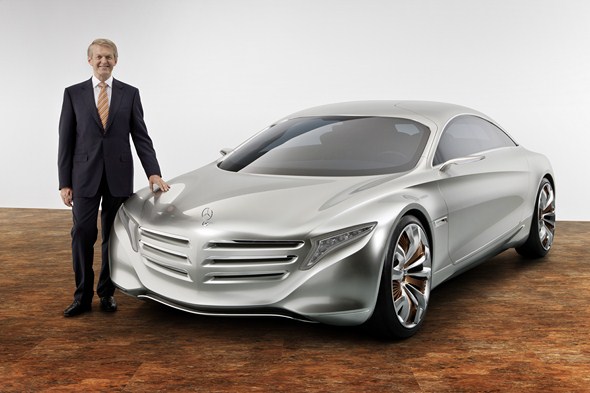
This study combines pioneering and highly efficient storage, drive and bodyshell technologies with unique control and display concepts. The research vehicle also presents itself with an expressive design which transfers the classic Mercedes design idiom into the future.
Highlights of the F 125!:
- Completely emission-free mobility with a range of up to 1000 kilometres, full day-to-day suitability, superior performance and first-class comfort.
- A bodyshell of innovative, lightweight hybrid construction with a high proportion of fibre-reinforced plastics and an intelligent mix of carbon-fibre, aluminium and high-strength steels, which allows a significant weight reduction while offering a further considerable improvement in safety. A high-strength construction with crash-responsive protective systems within the doors allows the omission of B-pillars, as well as the use of wide gull-wing doors which allow convenient access to the four seats. In this way the Mercedes-Benz safety philosophy and in particular the decisive principle of the rigid passenger cell developed by Béla Barényi in 1952 are being concertedly taken forward for the future of individual mobility.
- A high-voltage lithium-sulphur battery with a specific energy density of 350 Wh per kg at cell level, which allows considerably higher recuperation rates in combination with the e4MATIC all-wheel drive.
- A control and display concept based on touch, speech and hand-gestures makes the F 125! a true “companion” with whom the driver is able to interact flexibly and effortlessly. The gull-wing doors of light-weight CRP construction can also be opened and closed by hand-gestures.
- Highly attractive displays using 3D and projector-beam technology to open up new visual possibilities.
- Next-generation, substantially networked telematics allow internet-based voice control, integration into social media and extensive remote control of vehicle settings and entertainment functions.
- Innovative assistance systems for lasting driver stress relief, e.g. Advanced Driving Assist for semi-autonomous driving.
- Trailblazing exterior and interior design based on a completely new saloon architecture.
Revolutionary: structural integrated hydrogen composite storage unit
To store the hydrogen as the fuel of the future, Mercedes engineers adapted a technology which is still the object of basic research. This opens up completely new perspectives with respect to the vehicle architecture and operating range.
“The structural integrated hydrogen composite unit of the F 125! represents a real technological revolution, as it allows the hydrogen tank to be fully integrated into the bodyshell structure for the first time.
In the future, vehicles with emission-free fuel cell drive systems could achieve the operating ranges of current diesel models with no loss of interior space,” says Prof. Dr. Thomas Weber. Based on the current level of know-how, Mercedes specialists consider it possible that they may develop this technology to series production level from 2025.
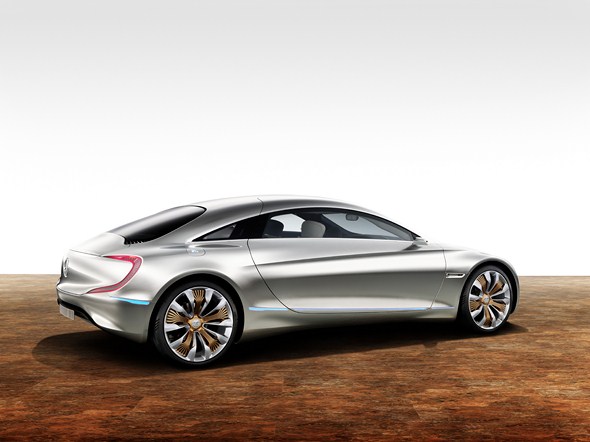
The tank integrated into the floor assembly has a capacity of around 7.5 kg of hydrogen. Compared to the high-pressure tanks in use today, the H2 tank potentially requires less installation space.
This is because to withstand a pressure of up to 700 bar, current tanks need to be cylindrical in shape, and owing to this round cross-section there are inevitably “cavities” between tanks installed next to or above each other. In contrast, tanks that can be filled at a pressure of 30 bar or less can be better integrated into the bodyshell. At the same time they are able to act as “structural” components.
Lithium-sulphur battery: compact and powerful
A highly advanced, very powerful lithium-sulphur battery is envisaged for the F 125!. It has a storage capacity of 10 kWh and is installed behind the rear seats. Combining the fuel cell drive system with the innovative lithium-sulphur battery makes a total operating range of up to 1000 km possible, of which up to 50 km can be under battery-electric power alone.
It can be inductively charged at “intelligent” charging stations, and the convenient charging process can be monitored by smartphone. When designing the F 125!, the developers worked on the assumption that by the time of its introduction into series production, this battery type will be capable of energy densities up to 350 Wh per kg.
This would represent roughly a doubling of current performance. The real potentials of this technology are however the subject of basic research, and are still difficult to assess at present.
Further development of the fuel cell as an energy source
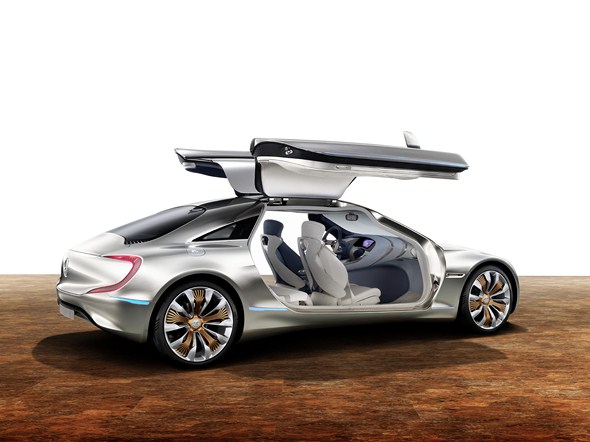
At the heart of the drive system lies a particularly powerful further development of the Mercedes-Benz fuel cell stack which has demonstrated its efficiency and day-to-day suitability e.g. in the successful B-Class F-CELL World Drive this year.
On 29 January, marking the 125th birthday of the automobile, Mercedes-Benz commenced the first circumnavigation of the globe with fuel cell powered electric cars in Stuttgart – covering more than 30,000 kilometres on four continents and through 14 countries. The three fuel cell powered B-Class cars and their backup vehicles returned safely to Stuttgart 125 days later.
The stack in the F 125!, which is further improved with respect to performance, consumption and practical suitability, provides the power for four powerful electric motors installed near the wheels, which ensure sporty, superior performance figures.
All in all the modular e4MATIC system, which also uses improved drive components from the SLS AMG E-CELL, generates a continuous output of 170 kW (231 hp) and a peak output of 230 kW (313 hp).
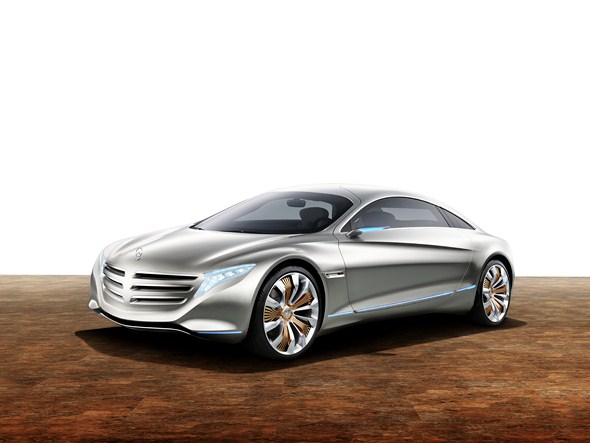
This accelerates the F 125! to 100 km/h in 4.9 seconds, with a top speed of 220 km/h. Nonetheless, NEDC fuel consumption is only 0.79 kilograms of hydrogen per 100 kilometres (= 2.7 litres diesel equivalent).
Always online, always connected: “@yourCOMAND”
With the visionary infotainment system “@yourCOMAND”, the F 125! provides an outlook on future Mercedes-Benz telematic systems. Its trailblazing features include:
In Natural Handling, operation is substantially by natural speech supplemented with touch and intuitive hand-gestures. In the interests of maximum driver-fitness and operating safety, the F 125! becomes the perfect, always alert companion for its driver and passengers.
The possibilities go well beyond those of current systems. The driver can e.g. request news items that are tailored to his personal needs, and make specific, contextual enquiries, without removing his hands from the wheel. The COMAND of tomorrow also becomes proactive.
In the future, the driver will be able to start with the traffic report or retrieve personal messages before the selected music programme begins. The weather report will then automatically come on before the journey ends, for example.
Thanks to the mood-based configuration function “Moods”, such individual adjustments will be completed in a matter of seconds in future. The F125! also opens up completely new dimensions when it comes to external communication and the use of social networks.
With the help of the Social Community Assistant, the driver alone can decide who is allowed to “disturb” him, or who receives information.
Thanks to the Seamless Experience functions, the multimedia systems of the F 125! are seamlessly and cross-functionally networked, socially interactive and non-distracting.
The exchange of information is no longer impeded or interrupted on journeys, but is an integral part of the concept. Because of constant connectivity with the Cloud, the driver has seamless access to all the media he normally uses.
The tedious synchronisation of different communication and entertainment devices is also completely eliminated. The so-called “digital lifestyle” of many customers can therefore be continued both seamlessly and safely when on board.
Sensory Perfection in the F 125! means high-end sound and high-resolution screens with brilliant, individual displays. If required, the autostereoscopic 3D display for spatial representation of the instrument cluster is able to show relevant information in clustered form. The 3D image adapts natural visual habits, allows a better overview and thus relieves the driver of stress.
The head unit in the upper section of the centre console uses projector-beam technology, and is controlled via a touchpad with 3D fingertracking located within easy reach of the driver. In addition to the head unit, the integrated selection bar enables the instrument cluster and rear-view display to be selected. Activated in this way, these displays can also be centrally operated.
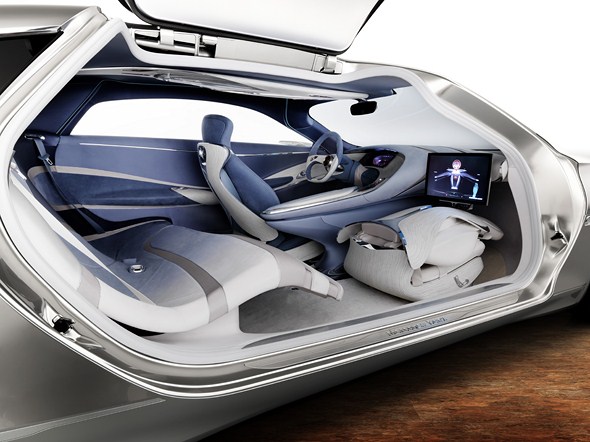
A further, retractable 17-inch display is installed on the front passenger side, and this is fully controlled by hand gestures. In this way a rear passenger can select his personal film programme with no physical contact.
A high-resolution wide-image display allows the entire traffic situation behind the vehicle to be conveniently monitored, and makes exterior mirrors unnecessary. The image is adapted to human perceptive powers at all times, and once again provides a much clearer overview with more rapid and intuitive registration of the relevant traffic situation.
The vehicle and its multimedia system, as well as all applications and contents, can be completely remote-controlled using the Remote Convenience functions.
This e.g. means that via the vehicle’s specific homepage, authorised individuals have access at all times to information such as the fuel level, next scheduled service or fuel consumption.
Just as easily, a home PC or of course a smartphone can be used for remote configuration of the onboard navigation or entertainment system, and to select individual interior temperature settings for each seat.
New assistance systems: recognising dangers, travelling in style
With the help of innovative driver assistance systems, the touring saloon of the future defuses even “invisible” hazards and relieves driver stress in many standard situations. If the driver requires, the F 125! is able to carry out frequently occurring driving manoeuvres autonomously.
Advanced Driving Assist allows lane-changes on multi-lane, one-way roads, and in a further development stage even automatic overtaking manoeuvres.
Thanks to radio-based networking with the environment, so-called Car-to-X communi-cation, the F 125! is also able to exchange information with other vehicles, a specially equipped infrastructure incl. traffic lights or warning signs and traffic control centres.
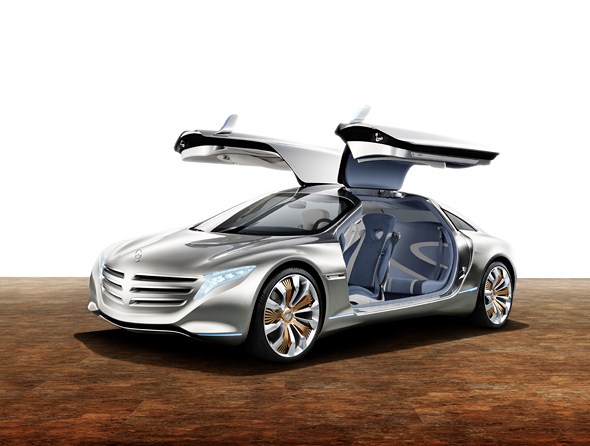
Specific applications might include a warning of approaching emergency service vehicles, well before the driver can see or hear them, a reminder that other vehicles have the right of way at obscure road junctions, or obstacles on the road.
Mobility of the future – Utopias shaping our tomorrow
It was visionaries and dreamers who prepared the way for “automobility”. The first tentative steps were taken at the end of the 19th Century – in a techno-logical environment where the steam engine dominated the world of power generation. The steam locomotive added motion to this machine, and tracks were laid everywhere.
The idea of fitting coach-like vehicles with compact, fast-running internal combustion engines to make individual, easy and comfortable mobility possible beyond the railway tracks was seen as “utopian” at the time – i.e. synonymous with “science fiction” or “fantasy”.
Visionary engineers and utopians such as Carl Benz, Gottlieb Daimler, Wilhelm Maybach or Rudolf Diesel refused to be daunted, however. With the F 125! Mercedes-Benz is once again demonstrating this pioneering spirit.
F 125! – a specific outlook on the vision of emission-free driving
With the new Mercedes-Benz research vehicle, the vision of emission-free driving with large, luxurious automobiles takes on a concrete form. The F 125! shows that the mobility of the future is emission-free and sustainable, comfortable and visually very appealing.
It embodies technical and design innovation, and shows the way towards a society able to cope without fossil fuels.
Technical data of the Mercedes-Benz F 125!
| Length (mm) | 4998 |
| Width (mm) | 1980 |
| Height (mm) | 1430 |
| Wheelbase (mm) | 3333 |
| Boot capacity (l) | 470 |
| Flywheel mass category (kg) | 1700 |
| Wheels | 7 1/2JX23 |
| Tyres | 245/35 R23 |
| Peak output of rear motors (kW/hp) | each approx. 100/136 |
| Torque of rear motors (Nm) | each approx. 200 |
| Peak output of front motors (kW/hp) | each approx. 50/68 |
| Torque (front motors) (Nm) | each approx. 75 |
| Total sustained output (kW/hp) | 170/231 |
| Total peak output (kW/hp) | 230/313 |
| Wheel torque (Nm) | 3440 |
| Acceleration 0-100 km/h (s) | 4.9* |
| Acceleration 80-120 km/h (s) | 3.2* |
| Top speed (km/h) | 220* |
| Hydrogen consumption (kg/100 km) | 0.79** |
| C02 comb. (g/km min./max.) | 0 |
| Total range acc. to NEDC (km) | 1000 |
| Capacity of solid H2 reservoir (kg) | approx. 7.5 |
| Energy content of lithium-sulphur battery (kWh) | 10 |
*target figures **2.7 l diesel equivalent
Technology
Effortless driving pleasure without harmful emissions
With its four powerful, wheel-mounted electric motors the F 125! is a particularly dynamic demonstration of the principle “fascination and responsibility”. Thanks to very generous performance reserves it copes effortlessly with any traffic situation – with no emissions whatsoever.
With its electric drive system based on highly advanced Mercedes-Benz fuel cell technology, the F 125! ensures particularly satisfying and sustained driving pleasure.
The electric power for the motors is generated on board by a chemical reaction between hydrogen and oxygen, or obtained from the efficient recuperation of braking energy.
The only emission resulting from the chemical reaction is pure water vapour. Total operating range is at the same level as a modern diesel car. The high performance potential of the electric drive components in the F 125! once again demonstrate the versatility of the highly scalable, modular E-Drive system from Mercedes-Benz.
Intelligently conceived vehicle architecture
In the new Mercedes-Benz research vehicle, the fuel cell stack is centrally located under the bonnet at the front, while the compact electric motors are installed near the wheels in the front and rear axle areas.
The composite hydrogen reservoir in the area of the centre tunnel, between the front seats and the floor assembly, has a capacity of around 7.5 kilograms and is ideally protected against the consequences of accidents.
Metal Organic Frameworks: the hydrogen reservoir of the future
Metal Organic Frameworks (MOFs) are porous solid bodies which consist of numerous, always identical basic components and can be very variably put together on a modular basis.
They are made up of nodal points known as Structural Building Units (SBUs). The connecting elements between these nodal points are formed by organic molecules known as Linkers.
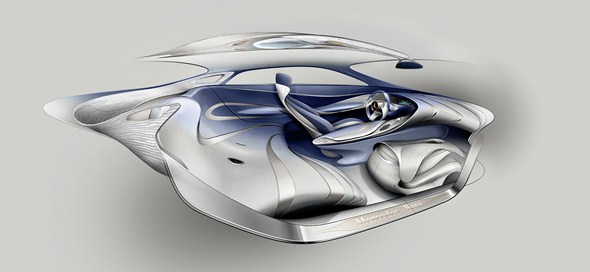
This structural principle allows solid bodies with extremely large specific surface areas, which in turn provides the basis for an enormous hydrogen storage capacity.
High storage capacity with low volume and great flexibility
Gigantic “inner” surfaces of up to 10,000 sq. m. per gram – the current status of research – make MOFs attractive for numerous applications: they are suitable as gas cleaners for fuel cells, for example, and also – as envisaged for the F125! – as a storage medium for gases, in this case hydrogen.
MOFs can be used as pressurised containers (30-80 bar), but for a higher storage density also as low temperature tanks at 77 K (around -196 degrees Celsius), i.e. considerably above the 20 K boiling point of hydrogen.
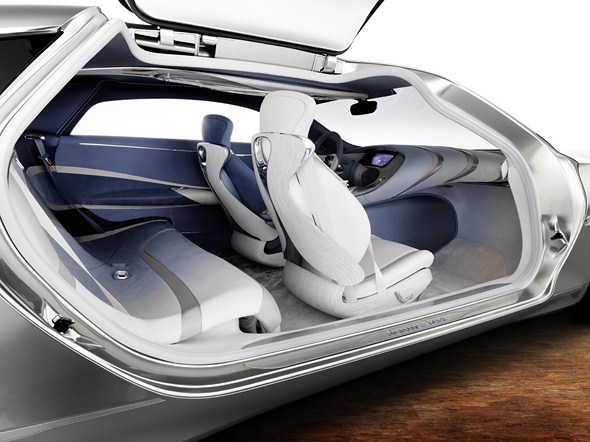
These attributes and the fundamental variability of the MOF’s shape allow an installation position suited to the vehicle requirements. This means that future MOFs can be flexibly installed in the body structure. Key advantages of this solution:
- Less installation space thanks to better adaptability means more scope for packaging and more room for the occupants.
- The low installed position is conducive to a low centre of gravity, with a positive effect on handling and driving dynamics.
- Full integration into the bodyshell structure ensures the best possible crash and operating safety.
Lithium-sulphur battery with a high energy density
The lithium-sulphur battery installed behind the rear seats has a storage capacity of 10 kWh. It can be inductively charged at “intelligent” charging stations, and the convenient charging process can be monitored and controlled using a smartphone.
The principal advantage of lithium-sulphur technology, whose usability in vehicles still requires further research, is the high specific energy density of the cells.
Compared to current batteries this allows relatively compact but highly efficient energy storage. When designing the F 125!, the developers worked on the assumption that by the time of its introduction into series production, this battery type will be capable of energy densities up to 350 Wh per kg.
This would represent roughly a doubling of current performance. The real potentials of this technology are however the subject of basic research, and are still difficult to assess at present.
All in all, the F 125! represents a further, important step towards the market maturity of a fuel cell powered car in the luxury class. With this research vehicle, Mercedes-Benz is demonstrating completely new future ways to design large and luxurious automobiles that are marketable, environmentally friendly and socially compatible.
Touring saloon with sports car genes
The use of four electric motors has a number of advantages in terms of driving dynamics. Mercedes-Benz has already delivered an impressive demonstration of the performance potential residing in this e4MATIC design with the battery-electric SLS AMG E-CELL super sports car, whose rear-end module was developed further for the F 125!.
The new front axle design provides a visionary outlook on the integration of electric drive systems into the front axle. The chosen positioning of the drive components allows optimal weight distribution, and also – thanks to active torque vectoring – the need-related assignment of power to each individual wheel.
Apart from ensuring optimal traction at all times, the electronic all-wheel drive with its wheel-specific yaw-damping improves handling stability at high speeds. During brisk cornering, however, wheel-specific intervention allows a metered increase in the yaw rate with an improved steering response and less steering effort.
This drive configuration also allows highly efficient energy recuperation at each wheel, cross-wind stabilisation, avoidance of load-change responses and therefore even more controllable handling when cornering, without the need for ASR (acceleration skid control) intervention.
Ride comfort at the highest level
110 years after the invention of the modern passenger car, the Mercedes Simplex of 1901, Mercedes-Benz is once again presenting a trailblazing, visionary vehicle concept – this time in the form of a sporty and comfortable touring saloon with an emission-free F-CELL Plug-in HYBRID system.
The concept anticipates future technological trends, with a vehicle architecture to suit.

The F 125! is the first electric car to feature an air suspension and continuous damper adjustment. The result is an optimal balance between ride comfort, driving dynamics and use of energy. The system also allows the vehicle’s suspension height to be adjusted as a function of speed and vehicle status – e.g. to improve the aerodynamics at fast motorway speeds.
Optimal traction and driving dynamics are ensured by active torque vectoring at the front and rear axles. The single-stage gears at the front and rear axles accelerate the vehicle comfortably and without interruptions in tractive power, right up to the top speed.
One technical highlight of the suspension system is special compensation of drive moments in the front axle, which almost entirely eliminates drive and recuperation influences on the steering, and noticeably reduces pitching.
Bodyshell concept
Effective lightweight construction with an intelligent material mix
Specific lightweight construction methods will make a considerable contribution to fuel economy in the automobiles of the future. Here too, Mercedes engineers take a comprehensive approach and use every means at their disposal to make vehicles bearing the Mercedes star lighter, and therefore more economical and efficient. Particular attention is paid to the bodyshell, which accounts for a major proportion of the vehicle weight.
Mercedes-Benz is already one of the largest users of aluminium in the automobile industry. However, the inventor of the automobile consciously opts not to rely only one material, but on a flexible, need-related mix of various metals and plastics. Mercedes-Benz expertise in this field is underlined by its large number of patent registrations in the field of production engineering and new materials.
14 percent of all new developments relate to lightweight construction materials and production processes, e.g. the use of CRP, and environmentally compatible manufacturing processes. CRP technology has long been firmly established in many areas of series production. Today Mercedes-Benz uses carbon-fibre reinforced plastics in various products – from buses to the Unimog, and right up to the AMG models.
Composite CRP materials, aluminium and high-strength steel alloys
With a combination of fibre-reinforced plastics (FRP) and a high content of carbon-fibre (CFRP), lightweight metals and high-strength steel alloys, as well as hybrid materials, precisely designed to meet the relevant requirements, the F 125! impressively demonstrates the great variety of possible applications.
Thanks to the intensive use of CRP, the lightweight construction specialists at Mercedes-Benz have been able to reduce the bodyshell weight of the research vehicle to around 250 kilograms – roughly 40 percent less than that of a comparable model in current series production.
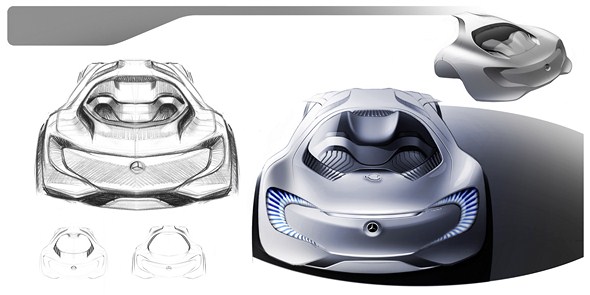
At the same time the level of safety has again been significantly improved. For example, the self-supporting structure of the gull-wing doors is a monocoque CRP design, with the material applied in four to 16 layers depending on the requirement.
In addition this component is equipped with a crash-responsive PRE-SAFE® structure. This large-surface side impact protector is “inflated” by sensor control like an airbag, enhancing the crash performance during a lateral collision.
This protection system first presented in the Mercedes-Benz Experimental Safety Vehicle ESF 2009 ensures that the volume in the impact area is enlarged, with a longer deformation path. Energy dissipation is thus improved without any design compromises becoming necessary.
Thanks to concerted lightweight construction, the doors are fitted with no visible gas-pressure struts or visually intrusive hinges with long lever arms. Instead the gull-wing doors are opened and closed with the help of electro hydraulic actuators fully integrated into the roof, and these are assisted by gas-pressure struts which are likewise concealed.
The front and rear side members of the F125! are completely of CRP, making roughly five times the energy absorption of a steel construction possible.
Intelligent use of CRP with the focus on safety-related areas
The front flexural and supporting structure is a load-bearing assembly of hybrid CRP sandwich construction. The door entry sills, rear end and pull-out luggage compartment of the F 125! are faced with carbon-fibre. The seat structure is also substantially of CRP, which ensures an extremely low weight and allows integration of the seat belt into the seat.
In the floor assembly – which accommodates the gas reservoir – mainly ultra-high-strength steel alloys and aluminium are used in combination with fibre-reinforced plastics. A bionically optimised metal/plastic hybrid construction is used for the A-pillars. For the front load dissipating path connecting the firewall and the floor assembly in the centre console area, the engineers have used a highly rigid honeycomb sandwich material.
Exemplary entry and seating comfort in a coupé atmosphere
In combination with an extremely long wheelbase of 3333 mm, the doors opening along the entire flank of the car allow extraordinarily convenient access and egress. By way of comparison, the figure for the current long-wheelbase S-Class is 3165 mm. Because the side windows are also fully retractable as a unit, the F 125! not only offers extremely generous interior space, but also the driving pleasure of a classic coupé.
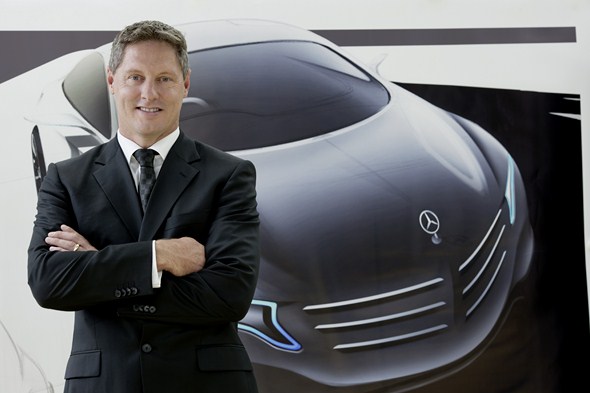
Telematics/control and display concept
Visionary infotainment system
With “@yourCOMAND” the F 125! shows a vision for future Mercedes-Benz telematic systems. The range of features includes:
- Natural Handling: operation is substantially by natural voice commands, supplemented with intuitive gestures and touch control.
- Seamless Experience: the multimedia systems are seamlessly and cross-functionally networked, socially interactive and non-distracting.
- Remote Convenience: the vehicle and its multimedia system, as well as all applications and content, can be fully pre-configured by remote control.
- Sensory Perfection: the F 125! offers high-end sound quality and high-resolution monitors with brilliant, individual displays for all seats.
The car as a fully interactive partner
The F 125! “understands” natural speech and gestures, and becomes the perfect, constantly alert “companion” for its driver and passengers. In the interests of maximum driver-fitness and operating safety, the driver is able to interact flexibly with the vehicle using voice commands and intuitive touch gestures.
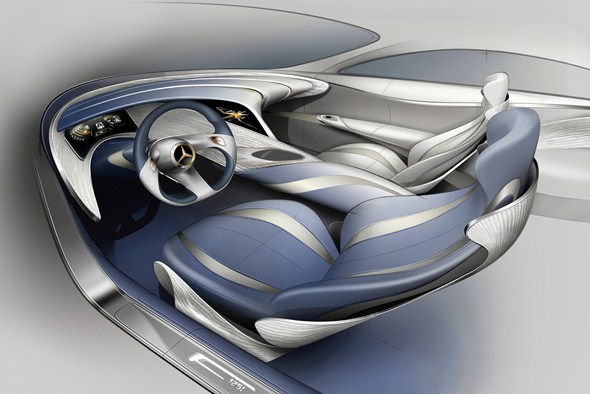
For the best possible accuracy level, the speech recognition system of the F 125! uses both onboard and – since it is always online – internet-based speech recognition.
Whether navigating, accessing news updates or receiving and sending SMS, email and Facebook messages, updating appointments or selecting enter-tainment media – the driver of the F 125! can control them all with natural voice commands.
The control options go well beyond those of currently available systems.
The driver is e.g. able to request the latest stock exchange information to suit his personal needs (“What is Daimler stock trading at?”) and make specific, contextual enquiries (“What developments are forecast by the analysts?”), choose music that suits his mood (“Please play romantic music!”) and listen to/answer incoming messages without taking his hands from the wheel.
Seamless Experience: man and machine are completely linked
Thanks to its mainly Cloud-based functions, the F 125! for the first time becomes a genuine, comprehensive “communication centre” which is able to provide all media and services at any time.
The exchange of information is no longer impeded or interrupted on journeys, but is an integral part of the concept. The so-called “digital lifestyle” of many customers can therefore be continued both seamlessly and – above all – safely when on board.
Because of constant connectivity with the Cloud, the driver has seamless access to all the media he normally uses.
The audio book he started at home yesterday evening can be continued from precisely the right point in the car, the music or TV programme he chose over breakfast is continued, and incoming messages are read out.
Always online and always up-to-date
As all the infotainment systems of the F 125! are concertedly “Cloud-based”, not only data but also functions in the network can be used. Speech recognition, for example, or a filtered search for news.
As another advantage, the tedious synchronisation of different communication and entertainment devices is completely eliminated. All information, playlists, address books, to-do lists and diaries are always up-to-date, and are always fully available during a journey.
The intelligent head unit: thinking infotainment
The COMAND of tomorrow will not merely respond, but also be proactive. In the future the driver will be able to start with the traffic report or retrieve personal messages before starting the individual music programme.
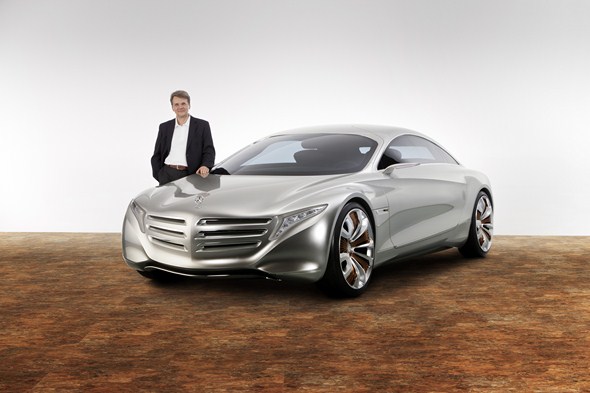
The weather report will then automatically come on before the journey ends. The vehicle will relieve the driver’s workload by accessing knowledge from the Cloud: if an urgent message cannot be delivered to a colleague by SMS, for example, it will suggest another means.
Social networking at a new level
The F125! also opens up completely new dimensions when it comes to external communication and the use of social networks. With the help of the Social Community Assistant, the driver alone can decide who is allowed to “disturb” him, or who receives information.
Friends and family, for example, can be informed about the current location or expected time of arrival at any time, while business calls or news can be rigorously blocked e.g. over the weekend.
Individual and extremely comfortable – to suit the mood
Whereas personalisation has often been tedious and awkward in the past, individual settings can be made very quickly and easily in the F 125!, thanks to the mood-based configuration function “Moods”. “Moods” allows simple and intuitive configuration of music, all climate control settings or the communication functions, thereby also contributing to driver-fitness safety.
Remote Convenience: regulating, finding and controlling from a distance
Fully networked at all times, the F 125! becomes an integral part of the “Cloud”. This e.g. means that via the vehicle’s specific homepage, authorised individuals have access at all times to information such as the fuel level, next scheduled service or fuel consumption. Just as easily, a home PC or of course a smartphone can be used for remote configuration of the onboard navigation or entertainment system, or to select individual interior temperature settings for each seat.
Via a computer or smartphone, using the so-called Object Spotter function, the driver is also able to locate objects in the vehicle, and even operate them if they are technically equipped for this. If he inadvertently leaves his mobile phone in the car, for example, he is still able to check for incoming calls and access mailbox messages. Luggage and clothing items, child seats or an umbrella can be “found” in the vehicle at any time using futuristic object recognition technology.
The Alert function provides additional security and convenience when away from home. If the doors or boot of the parked vehicle are opened, for example, marked items are removed from the interior or the vehicle is moved, the driver is immediately informed by an alarm message on his smartphone.
Sensory Perfection: natural vision and operation to perfection
The F 125! has large, high-resolution displays. The autostereoscopic 3D display for spatial representation of the instrument cluster is immediately in the driver’s field of vision. Depending on requirements or driver preference, it can show the relevant information in clustered form. The 3D image adapts natural visual habits, allows a better overview and thus relieves the driver of stress. The display is operated using two touchpads integrated into the steering wheel.
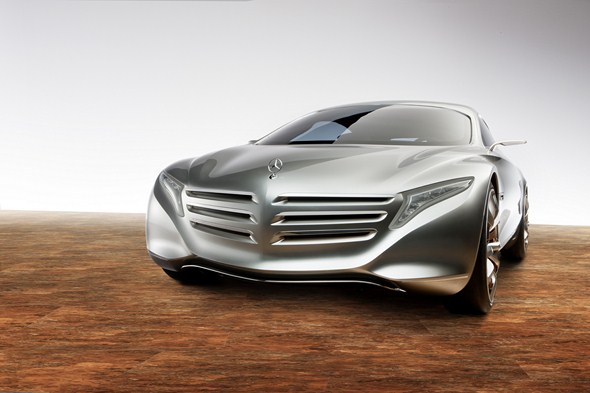
In the upper section of the centre console, the display surface is seamlessly integrated into the curved interior. This so-called head unit operates with projector-beam technology, and is controlled via a 3D select pad located within easy reach. It can still recognise a finger if it does not touch the surface directly, but is moving a few millimetres above it, a solution which allows a more stable display and control. In addition to the head unit, the integrated selection bar enables the instrument cluster and rear-view display to be selected. Activated in this way, these displays can also be centrally operated.
A further, retractable 17-inch display is installed on the front passenger side, and as this is primarily intended for passenger entertainment, it is fully controlled by hand gestures. To make this possible, infrared LEDs and a stereo camera are fitted along its lower edge. In this way a rear passenger who is relaxing on the chaise-longue can select his personal film programme with no physical contact.
A clear view of the entertainment screen from the front passenger side in the rear is made possible by the folding front passenger seat, which can be electrically adjusted at the touch of a button from the rear. The driver is unable to view this monitor, and is therefore not distracted from the traffic situation.
Hand gestures for convenient door opening and closing
Opening and closing the gull-wing doors is also contact-free, from the outside. Simple wiping gestures control all the functions. The relevant control element is integrated into the rear side window.
Door operation from outside is also possible by smartphone. Opening and closing from the interior is at the touch of a button, with control switches in both the front and rear.
Full visibility to the rear
Instead of conventional rear-view mirrors, the F 125! is equipped with a high-resolution wide-image display. This shows the images from a rear-facing stereo camera integrated into the third brake light. This allows the entire traffic situation behind the vehicle to be monitored, and also makes exterior mirrors unnecessary. In their place the F 125! has two aerodynamically shaped fins accommodating the sensors used by Blind Spot Assist.
The rear-facing stereo camera also allows extended image display possibilities, e.g. a view directly behind the rear end – with distance measuring function – when reversing into a parking space, or a longer-distance image for fast motorway driving. The image is adapted to human perceptive powers at all times, and once again provides a much clearer overview with more rapid and intuitive registration of the relevant traffic situation.
Active safety and assistance systems
Driver workload considerably reduced by new assistance systems
Arriving at the destination safely, rapidly and in a relaxed frame of mind: detecting traffic problems before they are seen, being aware of hazards before they become a threat. Intelligent mobility at a new level was another key focus during the development of the F 125!.
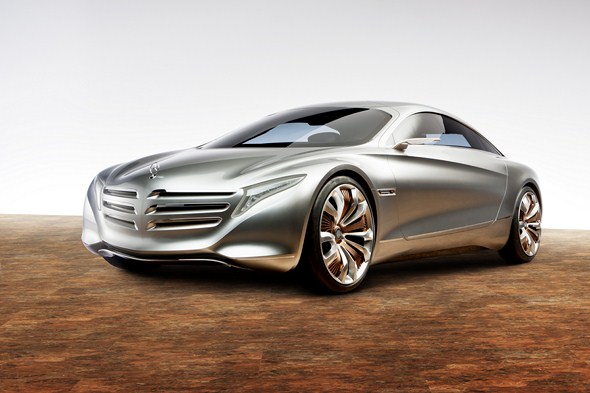
This is to be achieved by electronic networking of the vehicle and the external infrastructure – so-called Car-to-X communication. It allows information to be exchanged both between vehicles, and between vehicles and traffic control centres. In this way following and oncoming vehicles can be informed about potential hazards, enabling them to take timely and appropriate action in the relevant situation.
In Car-to-X communication, anonymised information about the traffic situation is also relayed to control centres so that further developments can be reliably predicted and the road infrastructure can be optimally configured in response. This information is in turn made available to road users, so that they can vary their routes accordingly and reach their destinations conveniently and safely in the shortest time.
Special WLAN-based radio technology
To ensure safe and reliable communication even in very dense traffic, a specially developed radio technology based on the well-known WLAN standard is used. Information is transmitted directly to other vehicles, or to stations installed along the roadside. In the event that the communication partner is not in direct transmission range, other vehicles can relay the information (“Multihopping”) or save it for later transmission (“Store & Forward”). In addition two-way radio technologies such as UMTS are integrated, so that gaps in WLAN coverage can be bridged (e.g. where there is no roadside infrastructure) or added value services can be offered.
Specific applications might include a warning of approaching emergency service vehicles, well before the driver can see or hear them, a reminder that other vehicles have the right of way at obscure road junctions, or rapid and precise relaying of information about obstacles or pedestrians on the road ahead.
Networked crossings, speed recommendations and optimised traffic light cycles also enable drivers to make efficient progress thanks to a series of green lights. The touring saloon of the future will therefore relieve the driver’s workload in many standard situations, defuse potential sources of danger and make for even more relaxed travel.
Advanced Driving Assist for semi-autonomous driving
When it comes to comfort the F 125! goes a whole stage further by autonomously performing certain frequent driving manoeuvres if the driver so wishes. On multi-lane, one-way roads, for example, Advanced Driving Assist allows autonomous cruising in the same lane (with or without vehicles immediately ahead) and safe, automatic lane-changing, and in a further development stage even overtaking manoeuvres.
In the process the F 125! controls both the linear and lateral vehicle movements, while its sensors “keep an eye on” other road users at all times. The driver merely needs to give the relevant command, leave his hands loosely on the steering wheel, lean back and relax. Naturally he is able to take back full control of the car at any time.
Exterior design
Expressive and unique: the sporty touring saloon of the future
The F125! represents a radical reinterpretation of a sports saloon. Its sensuous sportiness and dramatic, organic use of body surfaces, including a dropping line, are a pioneering further development of the current Mercedes-Benz design strategy. The two gull-wing doors allow convenient access and egress, also in parking spaces, and their opening mechanism is invisibly integrated into the rear triangular door panel on each side. Dispensing with exterior mirrors and door handles, plus the uninterrupted, single-piece bonnet with integral front wings, reduces the contours to the essential and lowers the drag coefficient. An electrically extending rear luggage module improves access to the boot.
Thanks to an emphatic change in the proportions, with the passenger compartment positioned well forward, the body appears to be cast from a single mould. The front and rear overhangs are reduced to a minimum. This layout allows an extremely long wheelbase which creates room for large gull-wing doors and maximum use of interior space. The gull-wing doors become the characteristic feature of the exterior, as they give access to the passenger compartment along the entire vehicle flank. As a result the exterior and interior appear to blend into an unmistakable and striking overall composition. The lack of a B-pillar also makes for easier access to the rear seats.
Striking front end with distinctive LED headlamps
The front end has sporty proportions and appears harmoniously integrated. It is characterised by an innovative grille set into the front architecture, suggesting the classic Mercedes-Benz radiator grille and ensuring an unmistakable brand signature. This is a meaningful aspect, for thanks to its fuel cell drive system the F 125! requires considerably less intake and cooling air. The completely joint-free bonnet underlines the sporty overall appearance of the vehicle silhouette, and has a dipped centre area. The floating, aerodynamic front wings add visual width to the front section.
The LED headlamps flanking the radiator grille are slim and dynamic in shape, lend a resolute look to the front end and, like numerous other features, convey a high-quality, high-tech impression. The interplay between design, function and energy consumption was optimised during the development process. Low-beam power consumption is 100 watts less than with conventional headlamps.
The bonnet has a stretched look, and dips at the centre. The so-called dropping line extends from the radiator grille and over the front wheels, then descends dramatically towards the rear where it forms a precise edge. Thanks to the alternating concave and convex surface contours, the side wall below the dropping line has an organic, arched effect. This muscular arching increases towards the front, where it envelops the front wheel. The rear axle is spanned by a powerful shoulder, which emerges from the beltline and is aerodynamically and abruptly delineated by the tail lights.
The wheels feature copper-coloured spoke elements, creating associations with the copper wire coils used in electric motors and making a visual reference to the car’s drive technology.
Inward-curving, C-shaped tail light clusters add a finishing touch to the rear end which accentuates the width and powerful stance of the car. The centre section of the rear end extends out electrically to give access to the luggage compartment. The lower area at the rear is rounded off by two aerodynamic fins which delineate the visually floating diffuser.
Serene yet dynamic: the F 125! reconciles apparent contradictions
The roof structure emerges organically, the A-pillars growing from the front end like sinews to blend into the roof. The C-pillar supports the roof at the sporty rear end, tapering as it descends in the manner of Mercedes-Benz coupés. The dramatic entry line (E-line), which becomes visible when the doors are opened, forms an elegant curve. The E-line, beltline, dropping line and rising “counter line” of the sill panels are reminiscent of tensed sinews in a muscular body, producing a harmonious overall picture.
The special night design with contour lights running just above the side sills optimises visibility from the side. In the dark the “counter line” becomes a continuous, illuminated blue band for better side visibility. Below the lower door edge, a carbon-fibre faced cover can be seen which surrounds the structure integrated hydrogen composite storage unit positioned behind it.
The design of the F 125! suggests dramatic harmony. Coming together at the front end, the lines accentuate the forward-thrusting, dynamic appearance. “In this way we have created contrasts in the visual perception: calm and quiet, yet dynamic,” says Mercedes-Benz Head of Design Gorden Wagener. “The real power lies in the elegant, muscular winds and the wheels: the wheels symbolise electric motors with terminals and coils, and make the drive concept visually tangible as well.”
Interior design
Interior with a lounge-like atmosphere
The interior likewise impresses with its futuristic, high-quality atmosphere. The design lines are innovative, and follow the examples of nature. Wood, Alcantara and silk are alternately entwined. The lines and contours vary from taut and sinewy to wave-like and dynamic and are constantly in flux. Light-coloured wood plays a central role in the decor, and extends throughout the interior. The minimised, formally integrated controls are everywhere incorporated into this natural material.
The centre console formally emerges from the dashboard and curves around the driver. The large star in the steering wheel forms the central core from which three wide, wooden spokes extend. The generous interior dimensions are similar to those of a current long-wheelbase S-Class, though the exterior dimensions are more akin to the E-Class.
Moreover, the interior of the F 125! combines two contrasting and highly emotional characteristics: while the cockpit has a very sporty and driver-oriented design, the rear opens up as an extremely relaxing lounge area. These contrasts are visually underlined by a varied colour scheme: dark in the front left and light in the right rear.
New dimension of comfort in the rear
The interior concept of the F 125! makes central brand values such as driving pleasure and ride comfort directly tangible. The intentionally chosen, pronounced asymmetry – the interior is not divided between front and rear in the usual way, but between the left and right halves – reflects the different form of use. Using switches in the centre console and rear door area, the rear seat backrest can be moved from upright to a chaise-longue position: the seat cushion extends forwards and a footrest folds out to provide a very comfortable resting position.
At the same time the front passenger seat is pushed forwards, which provides even more generous spaciousness in the rear and allows a clear view of the 17-inch display in the front passenger area. This is fully controlled by hand-gestures.
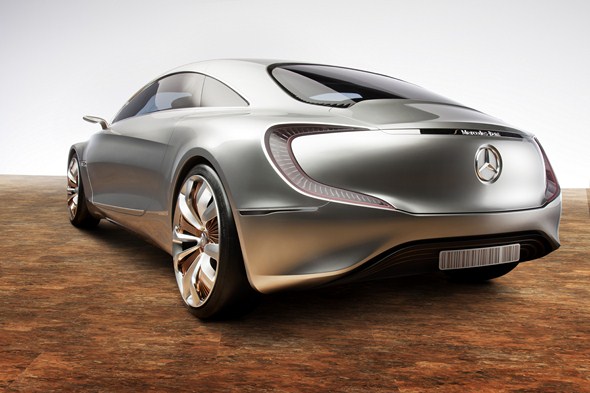
The shape of the F 125! was created in close collaboration between the technical research and development departments, as well as the Advanced Design Studios in Sindelfingen and Carlsbad/USA. The trailblazing interior was developed at the Mercedes-Benz Design Centre in Como, Italy.
Successful transfer from research to series production
Mercedes-Benz has presented 14 research vehicles since the early 1980s. This series of exciting and pioneering cars – beginning with the Auto 2000 in 1981 and leading up to today’s F 125! – offers proof of the consistency and foresight with which Mercedes-Benz engineers address the core issues of research and technology in order to develop innovative solutions for the future. Many systems that were first used in research vehicles and viewed as revolutionary at the time can now be found in Mercedes-Benz production cars, including e.g. a further development of the fuel cell drive system. This was first realised in October 2005, in the F 600 HYGENIUS, and entered series production in the B-Class F-CELL at the end of 2009.
The F 125! continues on this course. Like its predecessors, the model features key drive, comfort, and safety innovations, as well as an avant-garde design, all of which point the way forward for the series production of future Mercedes-Benz vehicles that will continue to deliver an impressive combination of fascination and responsibility even beyond the year 2025.
On the road to emission-free mobility
The goal of Mercedes-Benz is to offer every customer a vehicle that is precisely tailored to his needs. Accordingly the Mercedes-Benz Roadmap for sustainable mobility is divided into three areas of action:
- 1. Optimised vehicles with clean and efficient internal combustion engines
- 2. Further efficiency increases with hybridisation
- 3. Emission-free driving with fuel-cell and battery-powered vehicles.
With the F 125! research vehicle, Mercedes-Benz is demonstrating that with an appropriate configuration, electric drive is also suitable for large and luxurious cars. The fuel cell has proved to be the most promising option in this respect, as it ensures the best possible environmental compatibility while meeting the expectations of Mercedes customers with respect to superior performance and driving enjoyment.
The fuel cell: an important motor for the mobility of tomorrow
Mercedes-Benz fuel cell technology has already demonstrated its high performance and day-to-day suitability during the successful F-CELL World Drive. Its advantages – longer operating range, short refuelling times, zero emissions – are obvious to all.
What applies to all new drive systems also applies here, however: alternative drive systems require alternative infrastructures. In the case of the fuel cell this means hydrogen filling stations. This is why Mercedes-Benz as the inventor of the automobile is working with partners from industry and politics to further the development of an appropriate, full-coverage infrastructure.
As the latest example, Stuttgart-based Daimler and the technology company The Linde Group are furthering the creation of an infrastructure for hydrogen-fuelled fuel cell vehicles. Over the coming three years the two companies will construct 20 more hydrogen filling stations in Germany, thereby ensuring a reliable supply of exclusively regeneration-based hydrogen for the constantly growing number of fuel cell vehicles.
This initiative complements the existing infrastructure projects H2 Mobility and Clean Energy Partnership, which are being supported by the National Innovation Programme for Hydrogen and Fuel Cell Technology (NIP). This means that in an international comparison, Germany occupies a leading position with respect to hydrogen infrastructure.
Mobility of the future – Utopias shaping our tomorrow
It was visionaries and dreamers who prepared the way for “automobility”. The first tentative steps were taken at the end of the 19th Century – in a technological environment where the steam engine dominated the world of power generation. The steam locomotive added motion to this machine, and tracks were laid everywhere. At that time the very idea that a compact, fast-running internal combustion engine installed in coach-like vehicles could make individual, easy and comfortable mobility possible beyond the rail system was nothing short of blasphemous.
In fact all the indicators were far from promising. England, the leading industrial nation at the time, was completely committed to steam power. Paris, the second major engineering centre, was suffering political unrest. And in other at the time highly developed industrial nations, the conditions for visionary engineers and utopians such as Carl Benz, Gottlieb Daimler, Wilhelm Maybach or Rudolf Diesel were anything but ideal. Nonetheless, they refused to be daunted. With the F 125! Mercedes-Benz is once again reaffirming this pioneering spirit.
F 125! – a specific outlook on the vision of emission-free driving
With the new Mercedes-Benz research vehicle, the vision of emission-free driving with large, luxurious automobiles takes on a concrete form. The F 125! shows that the mobility of the future is emission-free and sustainable, comfortable and visually very appealing. It embodies technical and design innovation, and shows the way towards a society able to cope without fossil fuels.
Naturally the vehicle cannot stand alone as a solution for the vision of future mobility. The overall picture must include social and political efforts moving in the direction of the “Circular Economy” following the example of nature. The energy policy reversal discussed and in part initiated in Germany and many other countries is a seminal signal in this respect.
Other preconditions for the efficiency and convenience of future mobility are already being created by close networking between internet media. Apart from the “Cloud” as a data bank always accessible from anywhere, the next great step is the “Internet of Things”, networking of all physical objects. In the F 125!, integration into data networks and extended developments of intelligent assistance systems are already indicators of how comfort and safety are blending.
The mobility of tomorrow: less stress, more fun
In future visions of day-to-day mobility there are no more boundaries between road users, and traffic signs are almost unnecessary. As in swarms of fish or flocks of birds, collisions will be avoided by information, efficiency will increase, the infrastructure will occupy less space and mobility will become more stress-free. Numerous very pleasant side-effects of emission-free vehicles will add to
this, and change the world. Busy arterial roads in the cities will once again become attractive for living and shopping, as noise and exhaust fumes will disappear. Bypass roads will be reclaimed for other uses, and the present distinction between living/recreation and traffic areas will dissolve. New and revolutionary architecture will become possible in the cities.
The F 125! makes a tangible contribution to all these utopian ideas. While not forgetting that it also offers driving pleasure.
